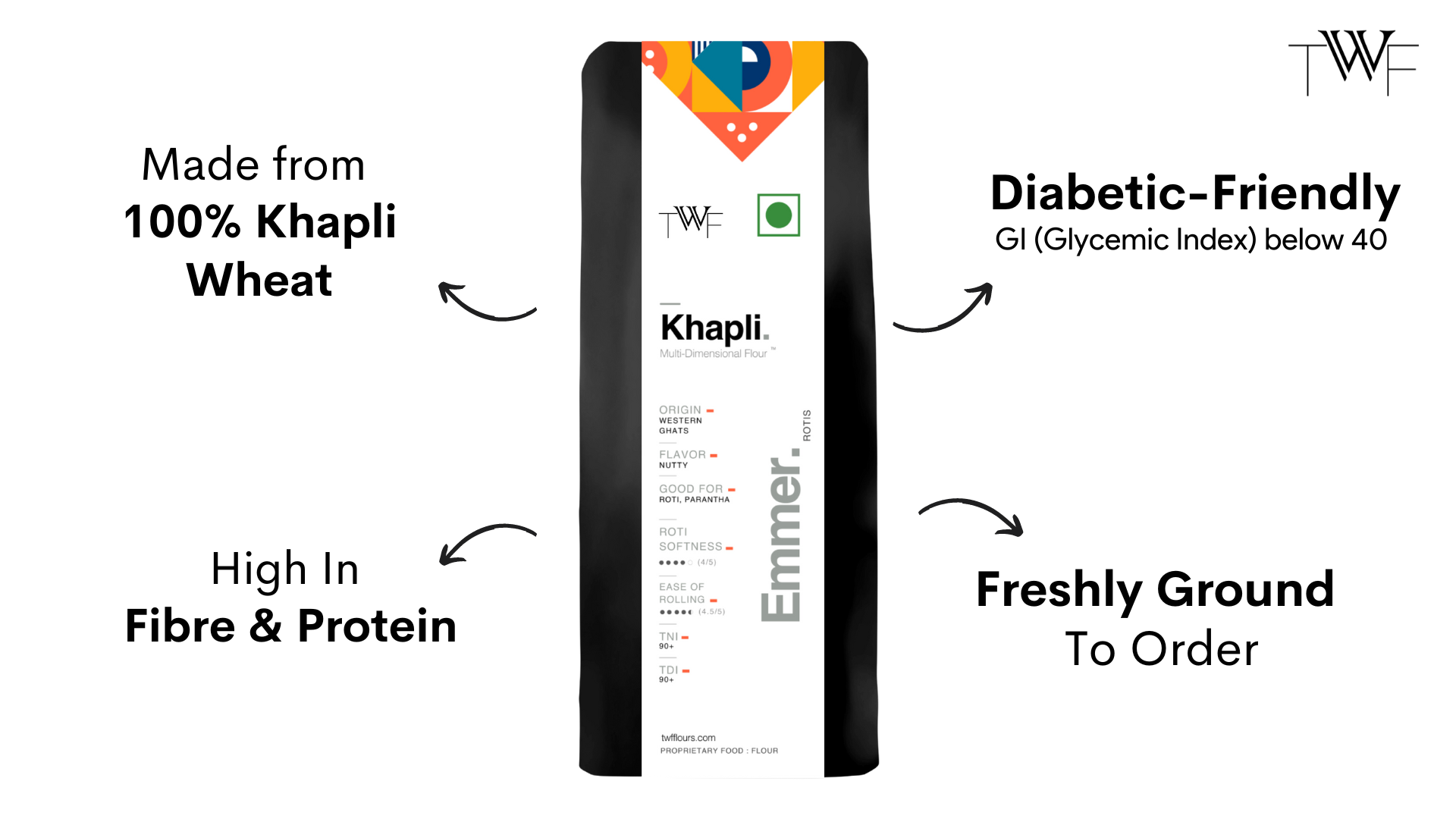Health Benefits of Khapli Wheat Flour (Atta): Why This Ancient Grain Is a Must-Have
Khapli Wheat Flour (atta), also known as Emmer wheat, is an ancient grain that has been cultivated for thousands of years. Unlike modern wheat, which has undergone extensive hybridization, Khapli wheat retains its natural, nutrient-dense properties. With the rising trend of healthier and more natural food choices, Khapli is gaining popularity as a wholesome alternative to refined flours. This blog will explore the benefits of Khapli wheat, the health benefits of ancient grains, and explain why this high-fiber flour should be a staple in your pantry.
What is Khapli Wheat?
Khapli wheat, also known by its scientific name Triticum dicoccum, is one of the oldest varieties of wheat. It is believed to be cherished in the regional diets of Maharashtra and Karnataka; and has been a significant part of traditional diets in India, the Mediterranean, and parts of the Middle East. Unlike modern wheat, Khapli wheat is less processed and not genetically altered, which means it retains a higher nutrient content.

Nutritional Profile of Khapli Wheat
One of the main reasons why Khapli wheat is making a comeback is its impressive nutritional profile. Compared to regular wheat, it contains:
- Higher levels of fiber
- More protein
- Essential vitamins and minerals like iron, magnesium, and zinc
- Beneficial antioxidants
- Low glycemic load
These attributes make Khapli wheat a nutritious alternative for those seeking a balanced diet. Let’s dive into the health benefits of ancient grains like Khapli wheat in detail.
Health Benefits of Khapli Wheat Flour (Atta)
1. Rich in Fiber: Promotes Digestive Health
One of the standout Khapli wheat benefits is its high fiber content. Fiber is essential for maintaining a healthy digestive system. It adds bulk to the stool, making it easier to pass and reducing the risk of constipation. Moreover, a diet high in fiber can also lower the risk of developing conditions like diverticulitis, irritable bowel syndrome (IBS), and colorectal cancer.
For those looking to manage their weight, Khapli wheat’s fiber content can help in feeling full for longer, thereby reducing overeating and snacking. This high-fiber flour makes a fantastic addition to any diet aimed at improving gut health.
2. Helps Control Blood Sugar Levels
Unlike refined wheat, which can cause rapid spikes in blood sugar, Khapli wheat flour (atta) has a lower glycemic index. This means it digests slowly, leading to a gradual release of glucose into the bloodstream. This is particularly beneficial for people with diabetes, as it helps in managing blood sugar levels. The complex carbohydrates found in Khapli wheat are digested more slowly, which prevents sudden sugar spikes and crashes.
If you’re managing diabetes or insulin resistance, incorporating Emmer wheat benefits into your diet could lead to more stable energy levels and better overall health.
3. Packed with Essential Nutrients
Khapli wheat is a powerhouse of essential nutrients. It contains vitamins like B-complex (B1, B2, B3) which are crucial for energy production and maintaining a healthy nervous system. It’s also rich in iron, magnesium, and zinc, which are important for various bodily functions, including muscle function, immunity, and bone health.
The higher protein content in Khapli wheat makes it a good choice for those looking to increase their protein intake without relying solely on animal sources. Ancient grain nutrition like that found in Khapli wheat can help in filling nutritional gaps that may be present in a typical diet.
4. Antioxidant Properties: Fights Inflammation
The health benefits of ancient grains go beyond just vitamins and minerals. Khapli wheat is rich in antioxidants that help fight oxidative stress in the body. Oxidative stress can lead to chronic inflammation, which is a risk factor for diseases like heart disease, diabetes, and even cancer. Antioxidants found in Khapli wheat can neutralize harmful free radicals, reducing the risk of these conditions.
Regular consumption of foods rich in antioxidants, like Khapli wheat, can lead to improved overall health and a stronger immune system.
5. Gluten-Sensitive but Not Gluten-Free
While Khapli wheat is not gluten-free, it is often easier to digest than modern wheat. This is because it contains a different type of gluten that is less likely to cause digestive issues for people with mild gluten sensitivity. However, it’s important to note that those with celiac disease should avoid Khapli wheat as it still contains gluten.
If you find modern wheat challenging to digest but do not have a full gluten intolerance, trying out Khapli wheat benefits might be worth considering.
How to Use Khapli Wheat Flour in Your Diet
Incorporating Emmer wheat benefits into your diet is easy. Here are a few simple ways to use Khapli wheat flour:
- Baking: Use Khapli wheat flour for making bread, cakes, and muffins. Its nutty flavor adds a unique twist to traditional recipes.
- Chapatis and Flatbreads: In India, Khapli wheat flour is often used to make chapatis, which are healthier than those made with refined flour.
- Pasta and Noodles: You can find or make pasta using Khapli wheat flour for a more nutritious option.
Conclusion
In a world where processed and refined foods have become the norm, embracing the health benefits of ancient grains like Khapli wheat can bring back essential nutrients that our bodies need. Whether you’re looking for a high-fiber flour to aid in digestion, seeking more sustainable sources of protein, or simply trying to manage your blood sugar levels, Khapli wheat can be a valuable addition to your diet. The Khapli wheat benefits extend beyond just nutrition; it is a symbol of a return to natural, wholesome eating habits that prioritize well-being.
Make the switch to TWF Khapli Wheat Flour today and experience the Emmer wheat benefits for yourself. Your body will thank you for making this simple, yet powerful, change.
Frequently Asked Questions (FAQs)
Q1. Is Khapli wheat the same as modern wheat?
No, Khapli wheat is an ancient variety of wheat that has not undergone the same hybridization processes as modern wheat. It retains more nutrients and is less processed.
Q2. Can I use Khapli wheat flour for gluten-free baking?
No, Khapli wheat flour is not gluten-free. However, it is often easier to digest than modern wheat, making it a better option for people with mild gluten sensitivity.
Q3. What are the main Khapli wheat benefits for health?
Some key benefits include high fiber content for better digestion, a lower glycemic index for blood sugar management, a rich nutrient profile, and antioxidant properties that help reduce inflammation.
Q4. Are there any side effects of consuming Khapli wheat?
For most people, Khapli wheat is safe and beneficial. However, those with celiac disease or severe gluten intolerance should avoid it.
Q5. How does ancient grain nutrition compare to modern wheat?
Ancient grains like Khapli wheat tend to have more fiber, protein, and essential vitamins and minerals compared to modern wheat. They are also less processed, retaining more of their natural nutrients.
Q6. Is all khapli flour the same?
No, not all khapli flour is the same. Khapli flour (also known as emmer wheat flour) can vary based on factors like the region it’s grown in, milling process, and quality standards, which affect its texture, color, and nutrient profile. Always check for authentic, high-quality sources.


Informative
Test response